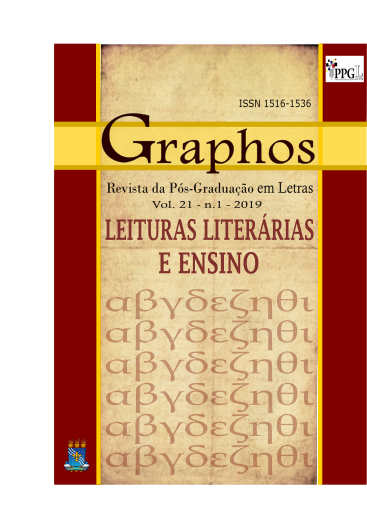Graphic elements influence in books for children in the contemporaneity: analysis of two works from the Children's University collection
Keywords:
Books for children, Multimodality, Graphic projectAbstract
Books for children are said to be an artistic-cultural object made up of several modes of languages. Thus, this paper departs from the assumptions of cultural semiotics, more specifically the theories about multimodality, and tries to identify both the discursive and educational aspects of works aimed at children published in contemporary times. Studies on illustration and graphic design of books for children, such as Nikolajeva and Scott (2011), van der Linden (2011), Ramos (2013) and Paiva (2018) are also used. This paper focuses specifically on the analysis of two books from Universidade da Criança [Children's University] collection, published by the label Estraladabão, by Federal University of Minas Gerais Press, in 2018: O que existe? O que não existe? (COSCARELLI, 2018) and O que é um livro? (RIBEIRO, 2018). Other professionals involved in the creation of the books are identified along this paper. Nowadays, books for children can be considered as an object of multiple authorship: besides the writer and the illustrator, the main authors or protagonists, as called in this paper, there are also other professionals, who were called secondary or coadjuvants authors, such as graphic designers, editors and specialized editorial coordinators, critical readers, content and language reviewers, and often also other editorial and educational specialists, such as advertisers, paper engineers, translators, adapters, psychologists, pedagogists and psychopedagogists. Some elements of the graphic design of the selected works and the relation between written text, illustration and design were analyzed in the following order: 1- Cover and fourth cover; 2- Format of the book and other elements of materiality; 3- Layout: how the written text and the visual are presented on the page, which includes a series of elements and relationships between them, such as: type and size of letter, space between lines and graphic spot (the area of the print: written text and illustration). It should be noted that the definition of this last element involves the relationship between written text and visual text. Finally, it is important to say that this paper is part of a collective research developed within the framework of the Group MULTDIC – Multiliteracies and digital information and communication technologies, entitled Literatura e visualidade: a importância do projeto gráfico em livros para crianças na contemporaneidade [Literature and visuality: the importance of the graphic design in books for children in contemporaneity].
Downloads
References
ARISTÓTELES. Poética. 2. ed. São Paulo: ArsPoetica, 1993.
BARTHES, Roland. O prazer do texto. Tradução J. Guinsburg. São Paulo: Perspectiva, 1996 (1976).
CAMARGO, Luís. Ilustração do livro infantil. Belo Horizonte: Editora Lê, 1995.
COPE, B.; KALANTZIS, M. Changes the Role of Schools. In: COPE, B.; KALANTZIS, M. (Org.). Multiliteracies: Literacy Learning and the Design of Social Futures. New York: Routledge, 2000. p. 121-234.
COSCARELLI, Carla. O que existe? O que não existe? Belo Horizonte: Editora UFMG, Estraladabão, 2018. Série: Ficção.
GEORGE, Patrick. Formas. São Paulo: Carochinha, 2016.
HUNT, Peter. Crítica, Teoria e Literatura infantil. Tradução Cid Knipel. São Paulo: Cosac Naify, 2010.
JAUSS, Hans Robert. O Prazer estético e as experiências fundamentais da poiésis, aisthésis e kathársis. In: LIMA, Luis Costa (Org.). A literatura e o leitor. Rio de Janeiro: Paz e Terra, 1979. p. 63-132.
KRESS, G.; VAN LEEUWEN, T. Multimodal Discourse: The modes and media of contemporary communication. London: Arnold, 2001.
KRESS, Gunther. Multimodality. A social semiotic approach to contemporary communication. New York, Routledge, 2010.
LEMKE, Jay L. Letramento metamidiático: transformando significados e mídias. In: Trabalhos em Linguística Aplicada. Campinas, 49(2): 455-479, Jul./Dez. 2010
MENDES, André. O amor e o diabo em Ângela Lago: a complexidade do objeto artístico. Belo Horizonte: UFMG, 2007.
PAIVA, Ana Paula Mathias de. Anotações de seminário promovido pelo grupo de pesquisa
MULTDICS. 8 de agosto de 2018. (notas de palestra)
RIBEIRO, Ana Elisa. O que é um livro? Ana Elisa Ribeiro, texto; ilustração Ana Cunha- Belo Horizonte: Editora UFMG, Estraladabão, 2018. (Série: Papel)
ROSENTHAL, Amy Krouse; LICHTENHELD, Tom. Pato! Coelho! São Paulo: Cosac Naify, 2010.
SANTOS, Zaira Bomfante; PIMENTA, Sônia Maria de Oliveira. Da semiótica social à multimodalidade a orquestração de significados. In: CASA: Cadernos de Semiótica Aplicada, v.12, n.2, 2014. p. 295-324
SAINT-EXUPÉRY, Antoine de. O pequeno príncipe. Rio de Janeiro, Editora Agir, 2009. Aquarelas do autor. 48ª edição / 49ª reimpressão. Tradução Dom Marcos Barbosa.
SMITH, B. A.; TAN, S.; PODLASOV, A.; O’HALLORAN, K. L. Orchestration of Meaning in Multimodal Semiosis and Semiotics. Social Semiotics, 2009.
VAN DER LINDEN, Sophie. Para ler o livro ilustrado. Tradução Dorothée de Bruchard. São Paulo: Cosac Naify, 2011.
YOYO BOOKS. Vrum clap-clap. São Paulo: Yoyo Books, 2016.







